We’ve all experienced the frustration of using eyedrops—missing the eye, feeling the liquid spill down our cheeks, or even tasting the medication moments after application. But what if this wasn’t just a minor inconvenience, but a fundamental flaw in drug delivery?
65 million people use eyedrops, with applications ranging from dry eye relief, allergy and infection treatment, and even post-surgical care. Despite their widespread use, eyedrops are exceptionally inefficient by design, leading to considerable treatment waste.
Each time you blink, tear fluid is wiped across the surface of your eye, constantly clearing environmental debris. This excess fluid ends up in the nose, which is why sometimes you can “taste” eyedrops when you put them in. The process is all a part of the human ocular system which includes the eye, its internal structures, supporting fluids, protective components and extraocular muscles.
“It's about the bioavailability of the eye,” Bishakh Rout, recent winner of a McGill Innovation Fund (MIF) Discover ($25,000) award, explained. “The eye can only absorb a certain amount of a drug at a time, with a maximum of 10% of a typically eyedrop making it inside the eye.” In other words, out of 100 micrograms of fluid administered, 90 micrograms are lost due to drainage.
Despite this being a well-known biological function in the industry, eyedrops are designed to administer drops larger than the human eye can hold, causing medication to be drained away by the ocular system, or to spill onto the face before it has a chance to be absorbed. While useful for flushing purposes, the feature counteracts successful medication delivery.
This wasteful practice is at the expense of patients, who are left wondering how their medication ran out so fast when they may already be grappling with high costs. Older patients in particular often find that eyedrops are difficult to apply, making treatment unnecessarily challenging. The result is ineffective delivery of eye medication and purposeful waste, with both consequences falling on the consumer.
Tackling A 2-Part Problem
For Rout, it’s all about improving medication delivery and reducing waste. Named OcuVista, Rout’s project is a novel design aimed at combatting inefficiencies in the eyecare industry. They are developing contact lenses that can deliver medicine directly to the eye, eliminating medical waste and improving useability.

The amount of medicine per eyedrop varies, but contact lenses by design are resource efficient, using less than half the amount needed for eye drops for a single use contact lens. “In short, the savings in terms of drug costs could be 40-60%,” Rout explained.
Contact lenses have been around for a while – probably longer than you think. In fact, Leonardo da Vinci imagined them in 1508, but the first glass lens (which would be placed over the entire eye) was only manufactured in 1887, drawing on designs from British astronomer Sir John Herschel. Soft plastic lenses were introduced in the late 1900s, evolving over time to become disposable and customizable. Remarkably, while the contact lens industry has evolved, OcuVista’s approach represents a groundbreaking leap in how we think about both medication delivery and eye care, rethinking how treatment is delivered to offer a more efficient and effective solution.
Founder Bishakh Rout is an expert in nanotechnology with a strong background in developing cutting-edge solutions across pharmaceuticals, cosmetics, and medical devices. Armed with a Chemical Engineering PhD from McGill, Rout has experience in both R&D and technology commercialization, and is passionate about transforming scientific breakthroughs into tangible solutions that improve lives. He is joined by Co-Founder Agnieszka Skalecka, an innovation strategist with expertise in life sciences, project management, and business development. Rout will be taking on a business development role while Skalecka will focus on the clinical side and day-to-day operations.
Introducing OcuVista
OcuVista emerged from extensive research driven by a pressing industry demand. "I could see the need,” Rout described. “Patients struggle to put drops in and most ends up wasted regardless.” Towards the end of his PhD in November of 2022, Rout was actively engaged in a variety of research and industry challenges. "At a certain point, all data pointed to this solution,” Rout remarked. And so, OcuVista was born with the aim to address efficiency and application simultaneously, allowing medication to be delivered over time, improving treatment and eliminating the inconvenience of application.
“I’ve seen many manufacturers try myriads of solutions,” Rout explained. OcuVista is unique because it can be integrated into existing manufacturing processes, making it a practical and scalable innovation in drug delivery. His solution is focused on adding one step within the contact lens supply chain rather than re-hauling the entire system, which would be costly and would require long-winded regulatory approval.

OcuVista is targeting glaucoma and dry eye patients currently, but exploring expansion in the foreseeable future. “We expect the cost savings to be tremendous,” Rout marveled. “We estimate no more than a 20% cost increase compared to existing contact lenses on the market, an exceptionally lower cost when compared to monthly eyedrop treatments.”
Excitement is high as the team moves toward commercialization. “We are so excited to be working with the MIF to bring our innovation to market,” Rout expressed. “They have already connected us with the right advisors, and we are itching to start working with their advice.”
In North America, their goal is to license their technology to big industry players, hoping to provide an alternative product alongside main eyedrop treatment methods. “We see the most direct influence by partnering with existing companies where our innovation can filter through existing supply chain methods,” Rout explains. In Asian markets, they are exploring the possibility to sell directly to consumers where their brand will be more readily accepted.
It's still early for OcuVista, but their passion is contagious. With the MIF, this year they have named their strategy “De-Risking”, where they will focus on the pathway of development, selecting specific customer segments and approaching key industry players for licensing. They will also continue to develop their prototype. “It's going to be an exciting year ahead, and we’re looking forward to the work we can accomplish with the help of the MIF," Rout said.

